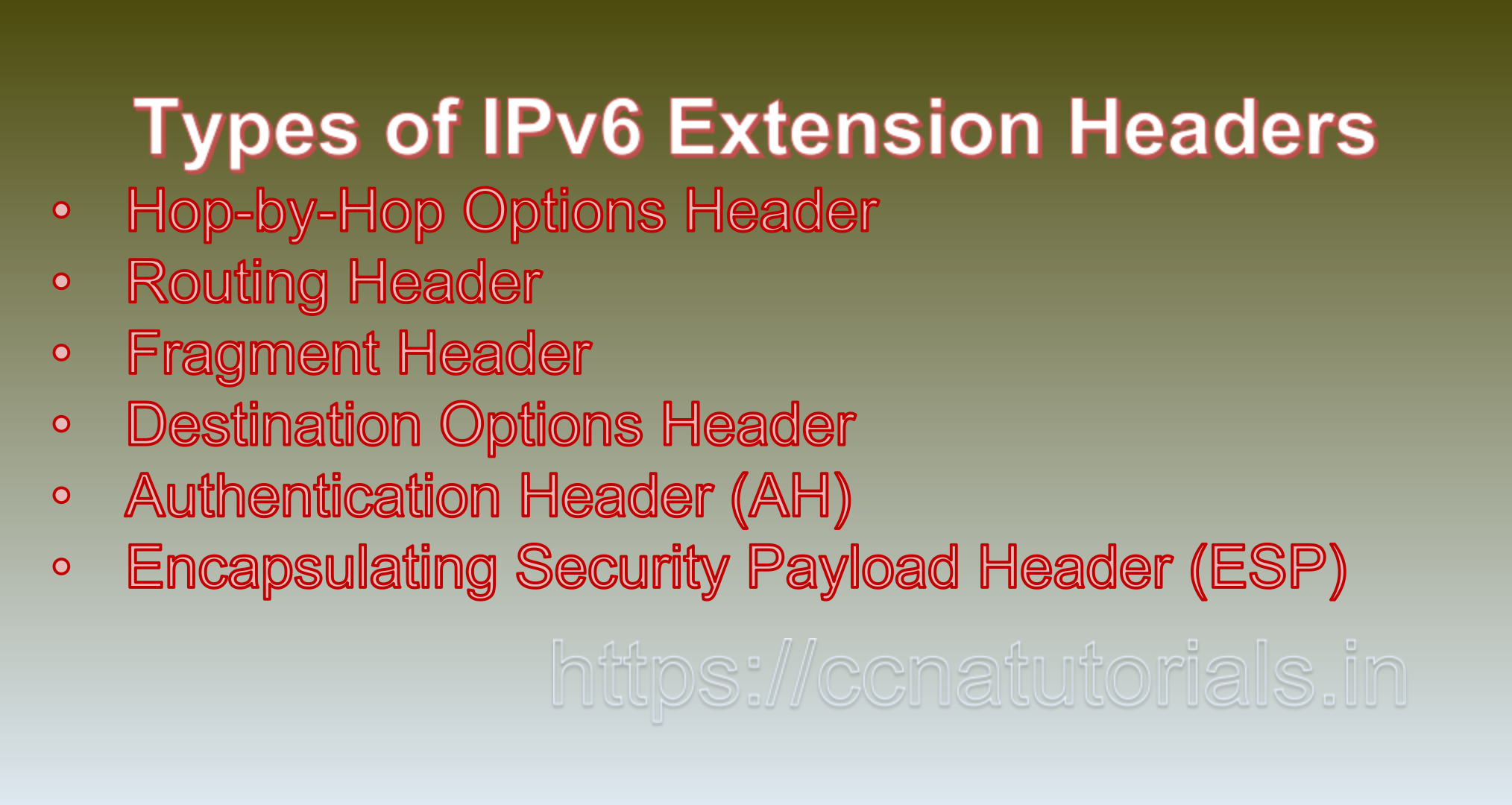Contents of this article
In this article, I describe IPv6 Extension Header Types: Enhancing Functionality and Flexibility in IPv6. IPv6, the next-generation Internet Protocol, introduces a flexible and extensible header structure that enables the inclusion of additional information beyond the traditional IPv6 header. These additional components, known as Extension Headers, allow for a wide range of functionalities to be added to IPv6 packets. This article delves into IPv6 Extension Header types, explaining their significance, purpose, and how they enhance the capabilities of IPv6 networking.
Introduction to IPv6 Extension Header Types:
IPv6 Extension Headers are optional components that can be added to the IPv6 packet header. They follow the main IPv6 header and provide the ability to include various types of additional information, facilitating diverse networking functions while maintaining backward compatibility with devices that don’t understand these extensions.
Types of IPv6 Extension Headers:
IPv6 introduces several types of Extension Headers, each designed to accommodate specific requirements and enhance networking capabilities. Here are the main types of IPv6 Extension Headers:
1. Hop-by-Hop Options Header:
This Extension Header is used for options that must be examined by every router along the path of the packet. It contains information that requires processing and possibly modification by each intermediate router.
2. Routing Header:
The Routing Header provides information that can be used to route packets through specific network paths. It allows the source to specify a list of intermediate routers that the packet should traverse before reaching the destination.
3. Fragment Header:
When a packet is too large to be transmitted over a network without fragmentation, the Fragment Header is used to indicate how the packet should be fragmented and reassembled at the destination.
4. Destination Options Header:
Similar to the Hop-by-Hop Options Header, the Destination Options Header contains options related to the final destination of the packet. However, unlike the Hop-by-Hop header, these options are processed only by the destination node.
5. Authentication Header (AH):
AH provides authentication and data integrity for the packet. It ensures that the packet hasn’t been altered during transmission and that it originates from a valid source.
6. Encapsulating Security Payload Header (ESP):
ESP is used for encryption and authentication of packet contents. It protects the confidentiality of the packet payload and can also provide authentication.
7. Mobility Header:
The Mobility Header is used in Mobile IPv6 to manage the mobility of nodes. It allows mobile devices to maintain connectivity while moving across different networks.
8. No Next Header:
This Extension Header indicates the end of the Extension Header chain. It is used when there are no more Extension Headers to process.
Benefits of IPv6 Extension Headers:
1. Flexibility:
Extension Headers enhance the flexibility of IPv6 by allowing new functionalities to be added without modifying the core IPv6 header structure.
2. Efficiency:
Extension Headers can be selectively included in packets, reducing overhead for packets that don’t require specific extensions.
3. Layered Functionality:
Different Extension Headers can be combined to achieve layered functionalities, such as combining security and routing options.
4. Future-Proofing:
IPv6 Extension Headers provide a mechanism for introducing new features in the future without needing to redesign the entire IPv6 header structure.
Example Scenarios:
1. IPv6 with Security:
Imagine a scenario where an organization wants to ensure secure communication over its IPv6 network. They can include both the Authentication Header (AH) and the Encapsulating Security Payload Header (ESP) Extension Headers in their packets. AH ensures data integrity and authentication, while ESP provides encryption for the payload, ensuring confidential communication.
2. IPv6 with Mobility:
In a mobile network environment, Mobile IPv6 can be used to enable seamless communication for devices that move between different networks. The Mobility Header Extension Header helps manage the mobility of these devices, ensuring uninterrupted connectivity.
In short IPv6 Extension Header Types
IPv6 Extension Headers are a key feature of the IPv6 protocol, offering enhanced flexibility and functionality compared to IPv4. By providing a modular way to include additional information in packets, Extension Headers enable a wide range of networking capabilities without requiring significant changes to the core IPv6 header structure. These headers play a vital role in optimizing network performance, enabling security measures, and accommodating future networking needs.

As IPv6 adoption continues to grow, Extension Headers will continue to play a pivotal role in shaping the future of networking. IPv6 Extension Header Types provide Enhancing IPv6 Functionality and Flexibility. IPv6 extension headers are an essential aspect of the IPv6 protocol, allowing for the inclusion of additional information and functionalities beyond the base IPv6 header. Extension headers enable various features such as fragmentation, security, mobility, and more while ensuring a flexible and extensible network architecture. This article provides a comprehensive overview of IPv6 extension header types, their purposes, and their significance in enhancing the capabilities of IPv6.
IPv6 Extension Header Overview:
The IPv6 header is designed to be simple and efficient, containing only the essential information required for routing and forwarding. However, the simplicity of the base header can limit the protocol’s ability to accommodate advanced features and functions. IPv6 extension headers address this limitation by allowing the insertion of multiple optional headers that extend the header chain. These headers are placed between the IPv6 base header and the upper-layer protocol header (such as TCP or UDP).
Types of IPv6 Extension Headers:
1. Hop-by-Hop Options Header:
– The Hop-by-Hop Options header is used to carry options that must be examined by each router along the packet’s path.
– It is typically used for network management, quality of service (QoS), and other functions requiring router attention.
– Options carried in this header are processed by every router and can impact packet forwarding behavior.
2. Routing Header:
– The Routing header allows the sender to specify a route for the packet to follow.
– It is useful in scenarios where specific routes need to be taken for efficient delivery, such as in mobile networks or multicast routing.
– Different routing types, including strict source route and loose hop-by-hop route, can be specified.
3. Fragment Header:
– The Fragment header is used to support packet fragmentation and reassembly when packets are too large for the network’s Maximum Transmission Unit (MTU).
– It is used to fragment and reassemble large packets, ensuring that they can traverse networks with varying link MTUs.
4. Destination Options Header:
– Similar to the Hop-by-Hop Options header, the Destination Options header carries options. However, these options are meant for the final destination rather than intermediate routers.
– This header is used for providing specific instructions to the destination node or for facilitating features like resource allocation.
5. Authentication Header (AH):
– The Authentication Header provides authentication and data integrity for the entire IPv6 packet.
– It ensures that the packet has not been altered in transit and that it originates from the expected sender.
6. Encapsulating Security Payload (ESP):
– The Encapsulating Security Payload header provides confidentiality, integrity, and authentication services to the packet.
– It encrypts the payload of the packet, ensuring that sensitive information remains secure.
7. Mobility Header:
– The Mobility header is essential for mobile IPv6, enabling the movement of devices across different networks without disrupting communication.
– It facilitates smooth handovers by managing the binding between a device’s home address and its current location.
Significance of IPv6 Extension Headers:
1. Flexibility and Extensibility:
Extension headers enable IPv6 to accommodate new features and functionalities without altering the base header structure. This enhances the protocol’s adaptability to evolving networking requirements.
2. Efficiency:
By allowing optional headers, IPv6 extension headers help conserve space in the main header, ensuring efficient use of network resources.
3. Enhanced Functionality:
Each extension header type serves a specific purpose, such as security, routing, or mobility. This modular approach enhances the protocol’s capabilities and versatility.
4. Specialized Features:
Different types of extension headers cater to specialized needs, such as security with AH and ESP or mobility support with the Mobility header.
Conclusion IPv6 Extension Header Types:
IPv6 extension headers significantly contribute to the versatility, flexibility, and functionality of the IPv6 protocol. By allowing optional headers to be inserted between the IPv6 base header and the upper-layer protocol header, extension headers enable advanced features, security, mobility, and more. Network administrators and designers can utilize these extension headers to implement specialized functionalities while ensuring efficient use of network resources. Understanding the various extension header types and their purposes is essential for building robust and adaptable IPv6 networks that can cater to diverse networking requirements and evolving technology trends. You may drop a comment below or contact us for any query related to this article.






